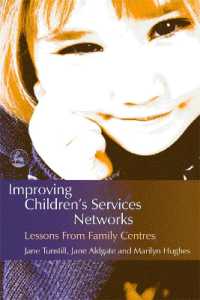Full Description
Over the last fifteen years, the South African postapartheid Transitional Amnesty Process - implemented by the Truth and Reconciliation Commission (TRC) - has been extensively analyzed by scholars and commentators from around the world and from almost every discipline of human sciences. Lawyers, historians, anthropologists and sociologists as well as political scientists have tried to understand, describe and comment on the 'shocking' South African political decision to give amnesty to all who fully disclosed their politically motivated crimes committed during the apartheid era. Investigating the postapartheid transition in South Africa from a multidisciplinary perspective involving constitutional law, criminal law, history and political science, this book explores the overlapping of the postapartheid constitution-making process and the Amnesty Process for political violence under apartheid and shows that both processes represent important innovations in terms of constitutional law and transitional justice systems. Both processes contain mechanisms that encourage the constitution of the unity of the political body while ensuring future solidity and stability. From this perspective, the book deals with the importance of several concepts such as truth about the past, publicly shared memory, unity of the political body and public confession.
Contents
Foreword
Abbreviations
Introduction
Preliminary Remarks
Post-apartheid Constitutionalism: Continuity and Discontinuity with the Tradition
Continuity Discontinuity: the Peculiarities of Post-apartheid Constitutionalism
The Establishment of the Post-apartheid Constitutional System
PART I: CONSTITUTION MAKING PROCESS AND PROCEDURE
Chapter 1. Constituent Facts
Apartheid's Legacy and Constructing the New Political Body's Unity
Unity as Collective Acceptance of Post-apartheid Constitutional Principles
The Dogma of National Unity, Common Citizenship and the Political Myth of the Rainbow Nation
Unity through the Technique of (Pre)Constitution
Making Negotiations: a Clash between Different Theories
African National Congress's Universalist Constitutionalism
National Party's and Inkatha Freedom Party's Relativist Constitutionalism
Unity through Fragmentation of the Constituent Act
Phases Dominated by Constituent Facts
The First Phase: Removal of Obstacles Phase
The Second Phase: Political Violence and Transition Obstacles
Chapter 2. Constituent Acts
Multiparty Assemblies: Gradual Predominance of Constituent Acts
Interim and Definitive Constituent Acts
Deciding Who Decides The Constitutional Principles
The Bill of Rights
A Break from the Past
The Genesis of the Truth and Reconciliation Commission
The Institution of the Constitutional Court: the Paradox of a Constituted Body
Co-participating in the Constituent Process
The Different Forms of Judicial Review Procedures
The Constitutional Court's Constituent Influence
The Conclusion of the Constitution Making Procedure
Notes on the Post-apartheid State and Government Forms
The Post-apartheid Constitution as Peace Treaty
PART II: THE CONSTITUENT ROLE OF THE TRUTH AND RECONCILIATION COMMISSION
Chapter 3. The Constitutional Suspension of a Strictly Criminal Approach
Introduction
The Functioning of the Truth and Reconciliation Commission
The Human Rights Violation Committee, Investigation Units and Public Special Hearings
The Amnesty Committee
Temporal and Subject Matter
Jurisdiction
Amnesty Hearing Procedure
The Relationship with Criminal Justice: Separation and Complementarity
The Impact of the Amnesty Process: Questioning Numbers
The Full Disclosure of All Relevant Facts and the Idea of 'Truth'
Constitutional Suspension of a Strictly Criminal Approach for Political Crimes Committed under Apartheid
Individual Volition as a Premise for the Suspension of a Strictly Criminal Approach
Post-TRC: Suspension or Definitive Cancellation of Criminal Justice for Political Crimes under Apartheid?
The Problems of Using a Criminal Approach during Regime Transitions
Post-conflict Justice in Europe between Hypertrophy of History and Law
Notes on Post-conflict Justice and Political Transitions outside of Europe
Chapter 4. Confession as a Strictly Constituent Act
Introduction
The Truth and Reconciliation Commission and the Constitution Making Process
Strictly Temporal Link
Formal and Legal Link
The Material Link
Confession as a Strictly Constituent Act
The Full Disclosure
The Attributes of the Confession
Confession as an Act of Capitulation
Confession: Constitution and Preservation of a Community's Unity
Amnesty as a Non Automatic Provision: Counterbalancing the Right to Pardon
Confession and Truth
Conclusion
Confession, Constituent Pact and an 'Absolutist' Communitarian
Constitutionalism
Bibliography
Index








